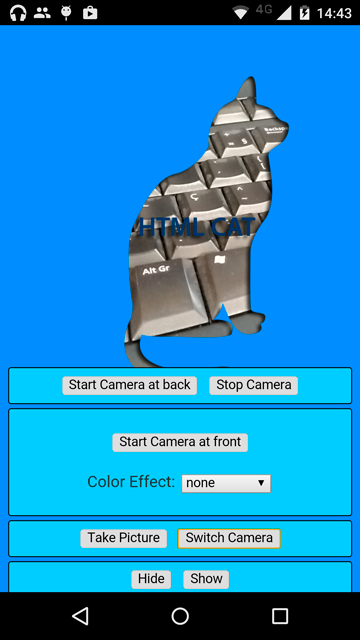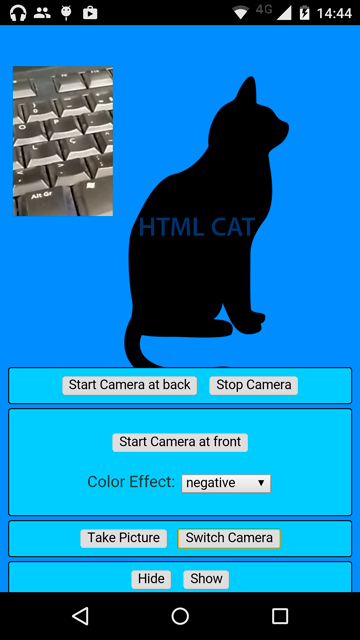Cordova plugin that allows camera interaction from HTML ee for showing camera preview below or above the HTML.
March 4, 2017 - We are currently drastically improving the plugin for a v1.0.0 release, in the meantime the API may change slightly. Please use master until a new version is released.
PR's are greatly appreciated. If your interested in maintainer status please create a couple PR's and then contact westonganger@gmail.com
- Start a camera preview from HTML code.
- Drag the preview box.
- Set camera color effect.
- Send the preview box to back of the HTML content.
- Set a custom position for the camera preview box.
- Set a custom size for the preview box.
- Set a custom alpha for the preview box.
- Set zoom, color effects, exposure mode, exposure mode compensation,
- Maintain HTML interactivity.
These are some features that are currently iOS only, however we would love to see PR's for this functionality in Android.
- Tap to focus
Use any one of the installation methods listed below depending on which framework you use.
cordova plugin add https://github.com/cordova-plugin-camera-preview/cordova-plugin-camera-preview.git
ionic plugin add https://github.com/cordova-plugin-camera-preview/cordova-plugin-camera-preview.git
meteor add cordova:cordova-plugin-camera-preview@https://github.com/cordova-plugin-camera-preview/cordova-plugin-camera-preview.git#[latest_commit_id]
<plugin spec="https://github.com/cordova-plugin-camera-preview/cordova-plugin-camera-preview.git" source="git" />
Starts the camera preview instance.
Options: All options stated are optional and will default to values here
x- Defaults to 0y- Defaults to 0width- Defaults to window.screen.widthheight- Defaults to window.screen.heightcamera- SeeCAMERA_DIRECTION- Defaults to front camera/code>toBack- Defaults to false - Set to true if you want your html in front of your previewtapPhoto- Defaults to true - Does not work if toBack is set to false in which case you use the takePicture methodpreviewDrag- Defaults to false - Does not work if toBack is set to false
let options = {
x: 0,
y: 0,
width: window.screen.width,
height: window.screen.height,
camera: CameraPreview.CAMERA_DIRECTION.BACK,
toBack: false,
tapPhoto: true,
previewDrag: false
};
CameraPreview.startCamera(options);When setting the toBack to true, remember to add the style below on your app's HTML or body element:
html, body, .ion-app, .ion-content {
background-color: transparent;
}Stops the camera preview instance.
CameraPreview.stopCamera();Switch between the rear camera and front camera, if available.
CameraPreview.switchCamera();Show the camera preview box.
CameraPreview.show();Hide the camera preview box.
CameraPreview.hide();Take the picture. If width and height are not specified or are 0 it will use the defaults. If width and height are specified, it will choose a supported photo size that is closest to width and height specified and has closest aspect ratio to the preview. The argument quality defaults to 85 and specifies the quality/compression value: 0=max compression, 100=max quality.
CameraPreview.takePicture({width:640, height:640, quality: 85}, function(base64PictureData){
/*
base64PictureData is base64 encoded jpeg image. Use this data to store to a file or upload.
Its up to the you to figure out the best way to save it to disk or whatever for your application.
*/
// One simple example is if you are going to use it inside an HTML img src attribute then you would do the following:
imageSrcData = 'data:image/jpeg;base64,' +base64PictureData;
$('img#my-img').attr('src', imageSrcData);
});
// OR if you want to use the default options.
CameraPreview.takePicture(function(base64PictureData){
/* code here */
});Get the flash modes supported by the device. Returns an array containing supported flash modes. See FLASH_MODE for posible values that can be returned
CameraPreview.getSupportedFlashModes(function(flashModes){
// note that the portrait version, width and height swapped, of these dimensions are also supported
flashModes.forEach(function(flashMode) {
console.log(flashMode + ', ');
});
});Set the flash mode. See FLASH_MODE for details about the possible values for flashMode.
CameraPreview.setFlashMode(CameraPreview.FLASH_MODE.ON);Set the color effect. See COLOR_EFFECT for details about the possible values for colorEffect.
CameraPreview.setColorEffect(CameraPreview.COLOR_EFFECT.NEGATIVE);Set the zoom level. zoomMultipler option accepts an integer. Zoom level is initially at 1
CameraPreview.setZoom(2);Get the current zoom level. Returns an integer representing the current zoom level. Android only
CameraPreview.getZoom(function(currentZoom){
console.log(currentZoom);
});Get the maximum zoom level. Returns an integer representing the manimum zoom level. Android only
CameraPreview.getMaxZoom(function(maxZoom){
console.log(maxZoom);
});Returns an array with supported exposure modes. See EXPOSURE_MODE for details about the possible values returned.
CameraPreview.getExposureModes(function(exposureModes){
console.log(exposureModes);
});Get the curent exposure mode of the device. See EXPOSURE_MODE for details about the possible values returned.
CameraPreview.getExposureMode(function(exposureMode){
console.log(exposureMode);
});Set the exposure mode. See EXPOSURE_MODE for details about the possible values for exposureMode.
CameraPreview.setExposureMode(CameraPreview.EXPOSURE_MODE.CONTINUOUS);Get the minimum and maximum exposure compensation. Returns an object containing min and max integers. Android only
CameraPreview.getExposureCompensationRange(function(expoxureRange){
console.log("min: " + exposureRange.min);
console.log("max: " + exposureRange.max);
});Get the current exposure compensation. Returns an integer representing the current exposure compensation. Android only
CameraPreview.getExposureCompensation(function(expoxureCompensation){
console.log(exposureCompensation);
});Set the exposure compensation. exposureCompensation accepts an integer. if exposureCompensation is lesser than the minimum exposure compensation, it is set to the minimum. if exposureCompensation is greater than the maximum exposure compensation, it is set to the maximum. (see getExposureCompensationRange() to get the minumum an maximum exposure compensation). Android only
CameraPreview.setExposureCompensation(-2);
CameraPreview.setExposureCompensation(3);Change the size of the preview window.
CameraPreview.setPreviewSize({width: window.screen.width, height: window.screen.height});CameraPreview.getSupportedPictureSizes(function(dimensions){
// note that the portrait version, width and height swapped, of these dimensions are also supported
dimensions.forEach(function(dimension) {
console.log(dimension.width + 'x' + dimension.height);
});
});Set specific focus point. Note, this assumes the camera is full-screen.
let xPoint = event.x;
let yPoint = event.y
CameraPreview.tapToFocus(xPoint, yPoint);Flash mode settings:
| Name | Type | Default | Note |
|---|---|---|---|
| OFF | string | off | |
| ON | string | on | |
| AUTO | string | auto | |
| RED_EYE | string | red-eye | Android Only |
| TORCH | string | torch |
Camera direction settings:
| Name | Type | Default |
|---|---|---|
| BACK | string | back |
| FRONT | string | front |
Color effect settings:
| Name | Type | Default | Note |
|---|---|---|---|
| AQUA | string | aqua | Android Only |
| BLACKBOARD | string | blackboard | Android Only |
| MONO | string | mono | |
| NEGATIVE | string | negative | |
| NONE | string | none | |
| POSTERIZE | string | posterize | |
| SEPIA | string | sepia | |
| SOLARIZE | string | solarize | Android Only |
| WHITEBOARD | string | whiteboard | Android Only |
Exposure mode settings:
| Name | Type | Default | Note |
|---|---|---|---|
| AUTO | string | auto | IOS Only |
| CONTINUOUS | string | continuous | |
| CUSTOM | string | custom | |
| LOCK | string | lock | IOS Only |
Note: Use AUTO to allow the device automatically adjusts the exposure once and then changes the exposure mode to LOCK.
It is not possible to use your computers webcam during testing in the simulator, you must device test.
cordova-plugin-camera-preview-sample-app for a complete working Cordova example for Android and iOS platforms.
Maintained by Weston Ganger - @westonganger
Created by Marcel Barbosa Pinto @mbppower

